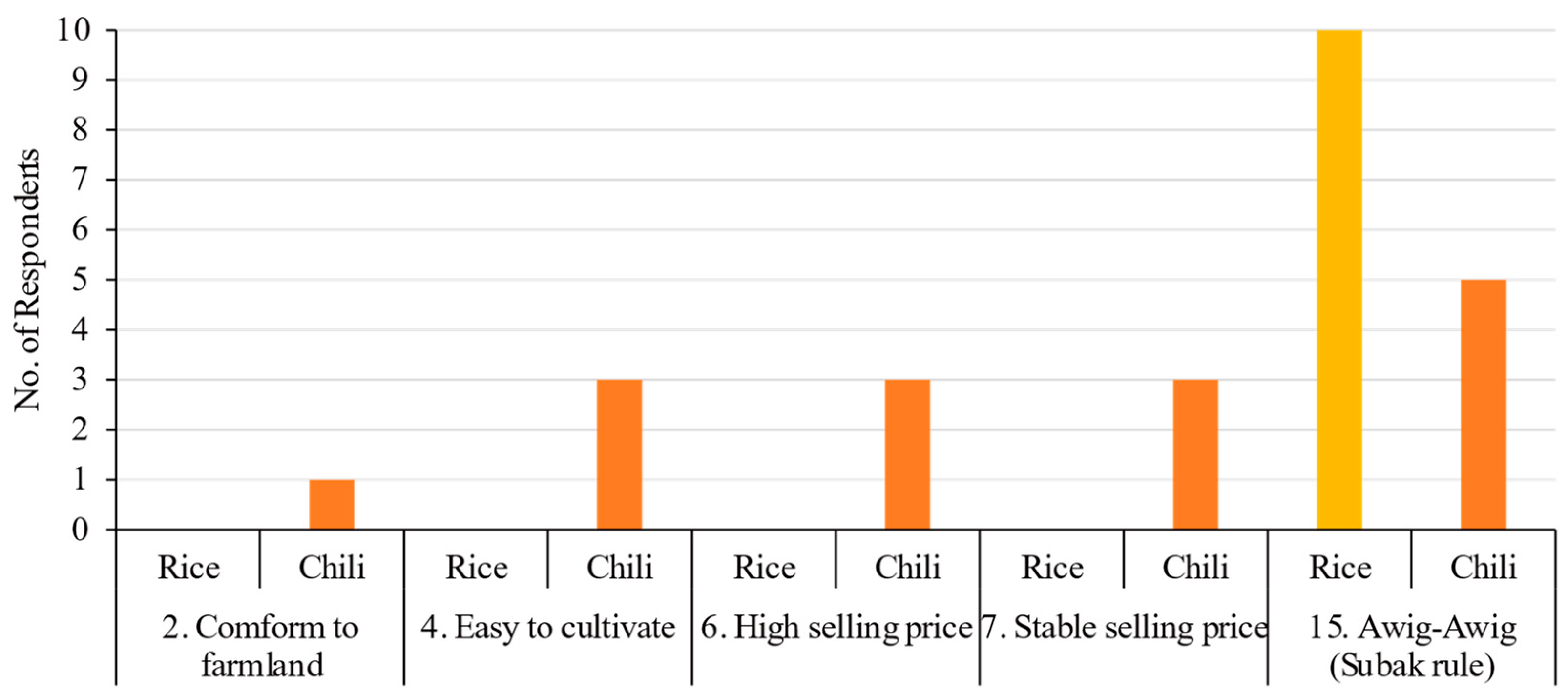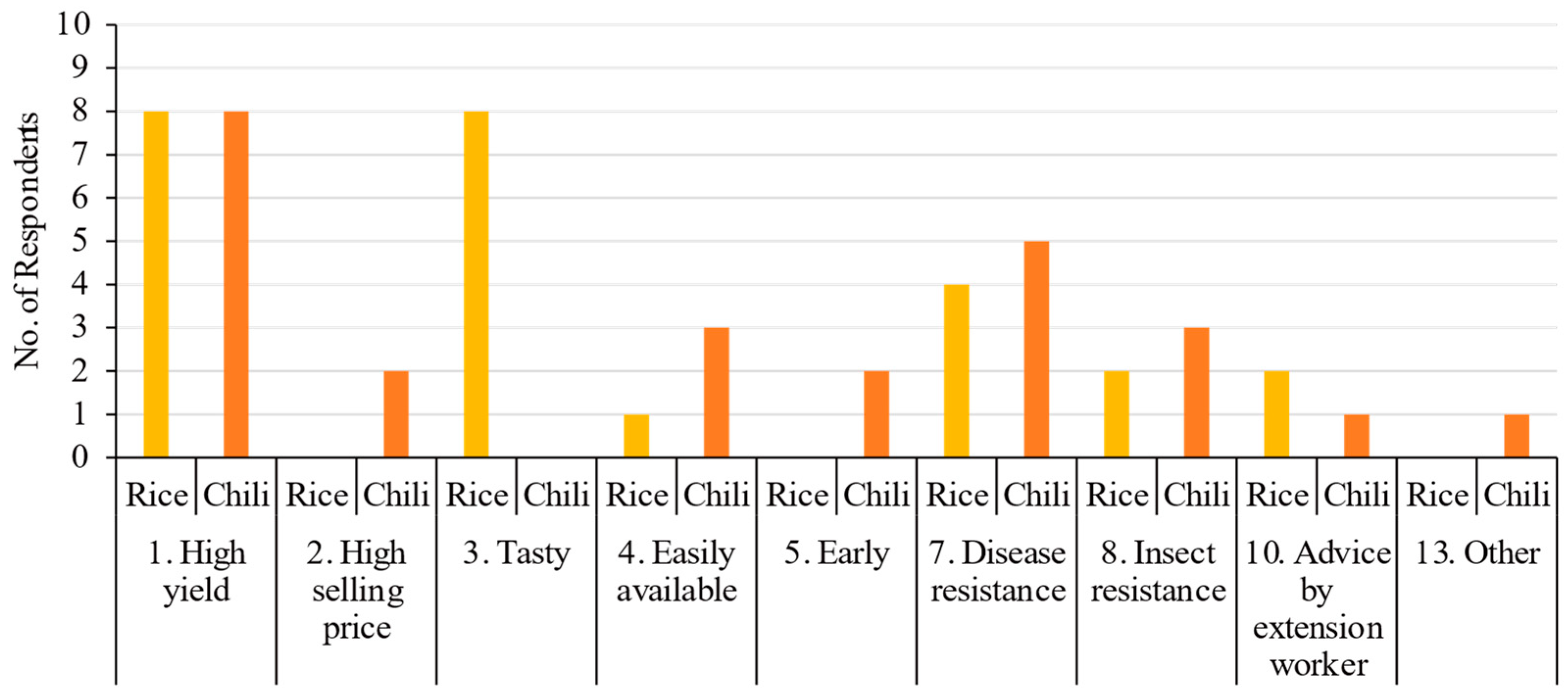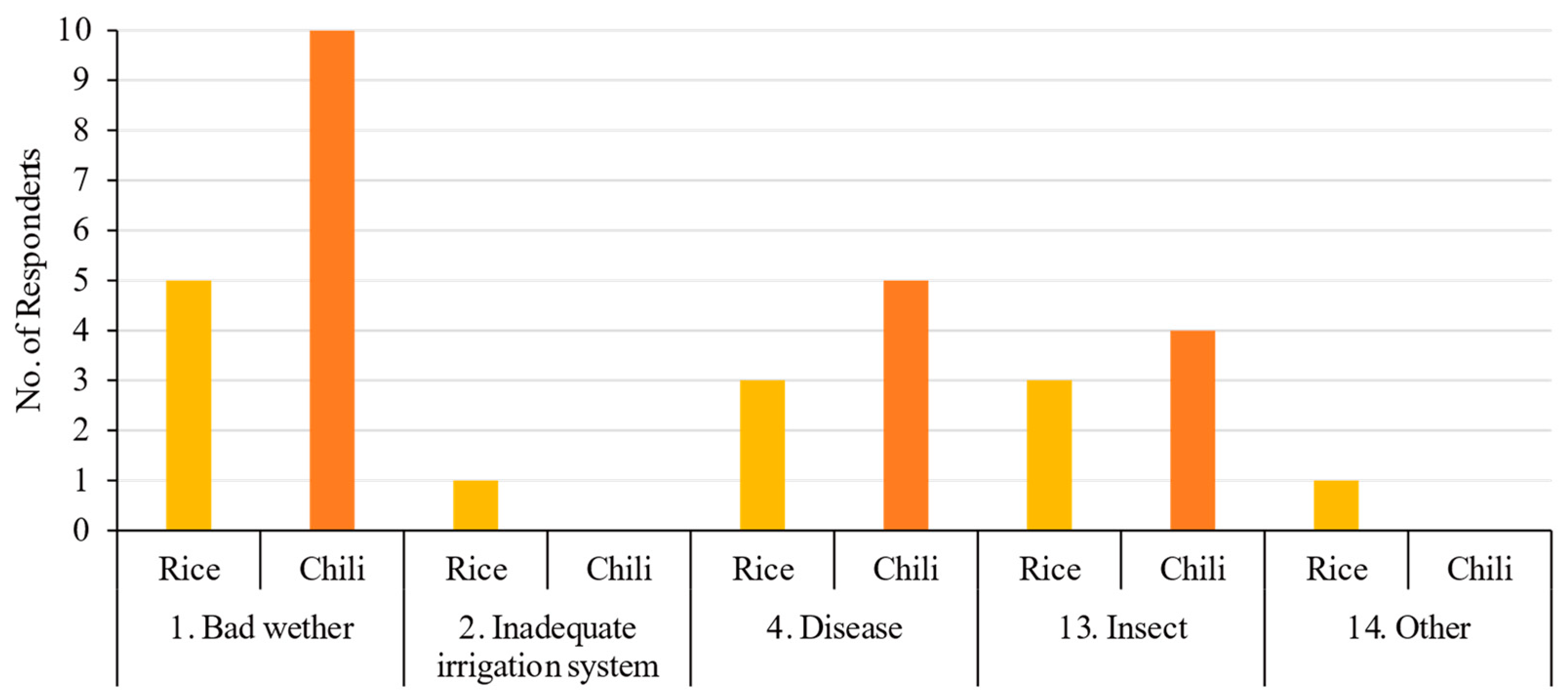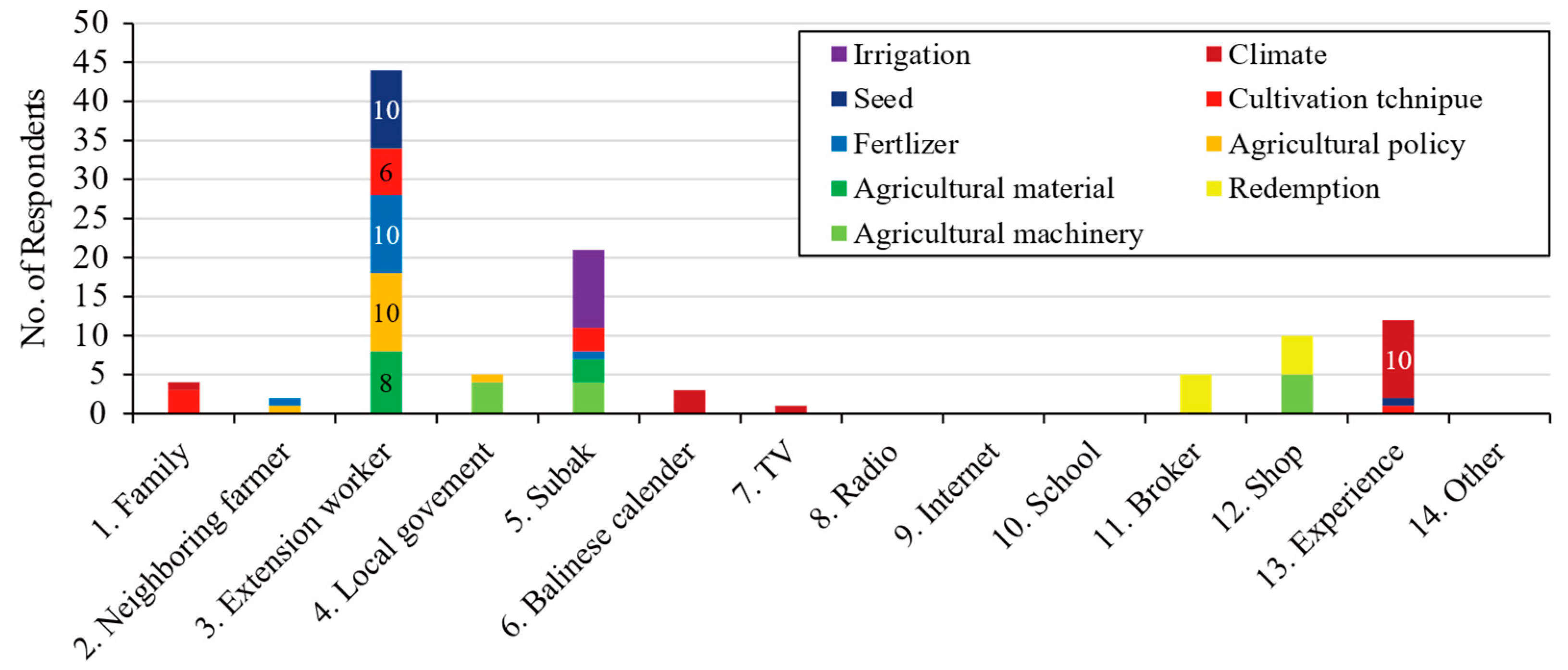Initiatives and Prospects for Sustainable Agricultural Production in Karangasem Regency, Bali, Indonesia
Abstract
1. Introduction
2. Materials and Methods
2.1. Survey Area Overview
2.2. Details of the Survey
3. Results
3.1. Information on Farmer Category, Farmland, and Main Crops
3.2. Planting System of Main Crops
3.2.1. Rice
3.2.2. Chili
3.3. Government Response to Limiting Factors in Cultivation
3.4. How Do Farmers Obtain Useful Agricultural Information?
3.4.1. Soft
3.4.2. Hard
3.5. Role of Agricultural Extension Workers as Sources of Agricultural Information
4. Discussion
4.1. Productivity and Sustainability
4.2. Sources of Information
5. Conclusions
Author Contributions
Funding
Institutional Review Board Statement
Informed Consent Statement
Data Availability Statement
Acknowledgments
Conflicts of Interest
References
- BPS. Statistik Wisatawan Mancanegara ke Provinsi Bali 2022; Badan Pusat Statistik: Bali, Indonesia, 2022. Available online: https://bali.bps.go.id/ (accessed on 7 November 2023).
- Widhianthini, W. Performance of Agricultural Sector in Bali. KnE Life Sci. 2022, 2022, 579–592. [Google Scholar] [CrossRef]
- Ginaya, G. The Balinese Calendar System: From Its Epistemological Perspectiveto Axiological Practices. Int. J. Linguist. Lit. Cult. 2018, 4, 24–37. [Google Scholar] [CrossRef][Green Version]
- Saito, H.; Hashimoto, A. Law and System of Traditional Irrigation Association “Subak” in Indonesia. J. Jpn. Soc. Irrig. Drain. Rural. Eng. 2017, 85, 865–870. (In Japanese) [Google Scholar] [CrossRef]
- Risna, R.A.; Rustini, H.A.; Buchori, D.; Pribadi, D.O. Subak, a Nature-based Solutions Evidence from Indonesia. IOP Conf. Ser. Earth Environ. Sci. 2022, 959, 012030. [Google Scholar] [CrossRef]
- Rahmi, D.H.; Setiawan, B. Pressures on the Balinese world cultural landscape heritage: The case of Jatiluwih Subak Village. IOP Conf. Ser. Earth Environ. Sci. 2020, 501, 012032. [Google Scholar] [CrossRef]
- Shiotsu, F.; Sakagami, N.; Asagi, N.; Suprapta, D.N.; Agustiani, N.; Nitta, Y.; Komatsuzaki, M. Initiation and Dissemination of Organic Rica Cultivation in Bali, Indonesia. Sustainability 2015, 7, 5171–5181. [Google Scholar] [CrossRef]
- Pimentel, D.; Harvey, C.; Resosudarmo, P.; Sinclair, K.; Kurz, D.; McNair, M.; Crist, S.; Shpritz, L.; Fitton, L.; Saffouri, R.; et al. Environmental and Economic Costs of Soil Erosion and Conservation Benefits. Am. Assoc. Adv. Sci. 1995, 267, 1117–1123. [Google Scholar] [CrossRef] [PubMed]
- Kementerian Pertanian Republik Indonesia. Rencana Strategis Kementerian Pertanian Tahun 2020–2024; Kementerian Pertanian: Java, Indonesia, 2020. Available online: https://rb.pertanian.go.id/upload/file/RENSTRA%20KEMENTAN%202020-2024%20REVISI%202%20(26%20Agt%202021).pdf (accessed on 30 October 2023).
- Ito, N. Indonesia-Toward Sustainable Agricultural Production and Food Consumption. In Country Reports for 2020: Thailand, Vietnam, Indonesia, Korea, China; Policy Research Institute, Ministry of Agriculture, Forestry and Fisheries: Tokyo, Japan, 2021; Volume 6, Chapter 3; pp. 1–16. Available online: https://www.maff.go.jp/primaff/kanko/project/R02cr06.html (accessed on 30 October 2023). (In Japanese)
- Arsil, P.; Tey, Y.S.; Brindal, M.; Ardiansyah; Sumarni, E.; Masrukhi. Perceived attributes driving the adoption of system of rice intensification: The Indonesia farmer’s view. Open Agric. 2022, 7, 217–225. [Google Scholar] [CrossRef]
- Suriani, N.L.; Suprapta, D.N.; Nazir, N.; Parwanayoni, N.M.S.; Darmadi, A.A.K.; Dewi, D.A.; Sudatri, N.W.; Fudholi, A.; Sayyed, R.Z.; Syed, A.; et al. A mixture of piper leaf extracts and rhizobacteria for sustainable plant growth promotion and biocontrol of blast pathogens in organic bali rice. Sustainability 2020, 12, 8490. [Google Scholar] [CrossRef]
- Badan Pangan Nasional. Indeks Ketahanan Pangan 2022; Badan Pusat Statistik: Bali, Indonesia, 2022. Available online: https://badanpangan.go.id/storage/app/media/2023/Buku%20Digital/Buku%20Indeks%20Ketahanan%20Pangan%202022%20Signed.pdf (accessed on 7 November 2023).
- Panuju, D.R.; Mizuno, K.; Trisasongko, B.H. The dynamics of rice production in Indonesia 1961–2009. J. Saudi Soc. Agric. Sci. 2013, 12, 27–37. [Google Scholar] [CrossRef]
- BPS. Proyeksi Penduduk Kabupaten/Kota Provinsi Bali 2020–2035 Hasil Sensus Penduduk 2020; Badan Pusat Statistik: Bali, Indonesia, 2020. Available online: https://bali.bps.go.id/ (accessed on 7 November 2023).
- BPS. Kabupaten Karangasem Dalam Angka 2023; BPS Kabupaten Karangasem: Bali, Indonesia, 2023. Available online: https://bali.bps.go.id/ (accessed on 30 September 2023).
- BPS Provinsi Bali. Luas Panen dan Produksi Padi Provinsi Bali 2022; Badan Pusat Statistik: Bali, Indonesia, 2023. Available online: https://bali.bps.go.id/ (accessed on 30 September 2023).
- BPS. Statistik Hortikultura Provinsi Bali 2022; Badan Pusat Statistik: Bali, Indonesia, 2023. Available online: https://bali.bps.go.id/ (accessed on 27 September 2023).
- Geria, I.M.; Sumardjo; Sutjahjo, S.H.; Widiatmaka; Kurniawan, R. Subak sebagai Benteng Konservasi Peradaban Bali. AMERTA 2019, 37, 39–54. (In Indonesian) [Google Scholar] [CrossRef]
- Dewi, R.K.; Parining, N. Risk Mitigation of Red Chili Production in the Village Besakih, Bali Province. J. Econ. Sustain. Dev. 2017, 8, 197–201. [Google Scholar]
- Shah, A.; Nazari, M.; Antar, M.; Msimbira, A.L.; Naamala, J.; Lyu, D.; Rabileh, M.; Zajonc, J.; Smith, L.D. PGPR in Agriculture: A Sustainable Approach to Increasing Climate Change Resilience. Front. Sustain. Food Syst. 2021, 5, 667546. [Google Scholar] [CrossRef]
- Takama, T.; Setyani, P.; Aldrian, E. Climate Change Vulnerability to Rice Paddy Production in Bali, Indonesia. In Handbook of Climate Change Adaptation; Leal Filho, W., Ed.; Springer: Berlin/Heidelberg, Germany, 2021; pp. 1–23. [Google Scholar] [CrossRef]
- Horisue, N. Agriculture in the World Today: Rice Cultivation in Bali, Indonesia. J. Agric. Soc. Jpn. 2015, 1600, 46–51. (In Japanese) [Google Scholar]
- Norken, I.N. Efforts to preserve the sustainability of subak irrigation system in Denpasar city, Bali Province, Indonesia. In Proceedings of the International Conference on Advances in Civil and Environmental Engineering (ICAnCEE 2018), Bali, Indonesia, 24–25 October 2018; MATEC Web Conf: Paris, France, 2019; Volume 276. [Google Scholar] [CrossRef]
- Hayashi, K.; Llorca, L.P.; Bugayong, I.D.; Agustiani, N.; Capistrano, A.O.V. Evaluating the Predictive Accuracy of the Weather-Rice-Nutrient Integrated Decision Support System (WeRise) to Improve Rainfed Rice Productivity in Southeast Asia. Agriculture 2021, 11, 346. [Google Scholar] [CrossRef]
- Tewolde, F.T.; Shiina, K.; Maruo, T.; Takagaki, M.; Kozai, T.; Yamori, W. Supplemental LED inter-lighting compensates for a shortage of light for plant growth and yield under the lack of sunshine. PLoS ONE 2018, 13, e0206592. [Google Scholar] [CrossRef] [PubMed]
- Widyastuti, Y.; Satoto; Rumanti, A.I.; Wibowo, P.B.; Ruskandar, A.; Widyantoro; Rachmawati; Zaini, Z. “Small farmer large field”, a new model to developing and improving adoption of hybrid rice technology in Indonesia. In Proceedings of the 1th International Conference on Agriculture and Rural Development (ICARD), Banten, Indonesia, 8–9 August 2019; IOP Conference Series: Earth and Environmental Science. IOP Publishing Ltd.: Bristol, UK, 2019; Volume 383, p. 012052. [Google Scholar] [CrossRef]
- BPS. Statistik Hortikultura Provinsi Bali 2018; Badan Pusat Statistik: Bali, Indonesia, 2019. Available online: https://bali.bps.go.id/ (accessed on 27 September 2023).
- Taufik, M.; HS, G.; Syair, S.; Mallarangeng, R.; Khaeruni, A.; Botek, M.; Hartono, S.; Aidawati, N.; Hidayat, P. Distribution of Yellow Leaf Curl Disease on Chili in Southeast Sulawesi and Identification of the Causal Agent. J. Fitopatol. Indones. 2023, 19, 89–98. (In Indonesian) [Google Scholar] [CrossRef]
- Selangga, D.G.W.; Hidayat, S.H.; Susila, A.D.; Wiyono, S. The Effect of Silica (SiO2) to the Severity of Yellow Leaf Curl Disease on Chili Pepper. J. Perlindungan Tanam. Indones. 2019, 23, 54. [Google Scholar] [CrossRef]
- Setiawati, W.; Udiarto, B.K.; Soetiarso, T.A. Pengaruh Varuetas dan Sistem Tanam Cabai Merah terhadap Penekanan Populasi Hama Kutu Kebul. J. Hortik. 2008, 18, 55–61. (In Indonesian) [Google Scholar]
- Arfiani, N.; Nasruddin, A. Control of Pepper yellow leaf curl Indonesia virus and Its Vector (Bemisia tabaci Genn.) on Chili Plants (Capsicum annum L.) Using Resistant Variety and Insecticide Application. Earth Environ. Sci. 2023, 1230, 012119. [Google Scholar] [CrossRef]
- Penyerahan Pupuk Hayati Cair (PHC) Dalam Rangka Pengembangan Pertanian Organik. Available online: https://distanpangan.baliprov.go.id/penyerahan-pupuk-hayati-cair-phc-dalam-rangka-pengembangan-pertanian-organik/ (accessed on 23 December 2023). (In Indonesian).
- Fahad, S.; Adnan, M.; Noor, M.; Arif, M.; Alam, M.; Khan, I.A.; Ullah, H.; Wahid, F.; Mian, I.A.; Jamal, Y.; et al. Major Constraints for Global Rice Production. In Advances in Rice Research for Abiotic Stress Tolerance; Hasanuzzaman, M., Fujita, M., Nahar, K., Biswas, J.K., Eds.; Woodhead Publishing: Cambridge, UK, 2019; pp. 1–22. [Google Scholar] [CrossRef]
- Sari, I.J.; Wahyuni, I.; Khastini, R.O.; Awaliyati, E.; Susilowati, A.; Utari, E.; Aryantha, I.N.P. Characterization of Plant Growth Promoting Rhizobacteria (PGPR) on Capcisum annum. J. Biodjati 2021, 6, 255–263. [Google Scholar] [CrossRef]
- Thilagar, G.; Bagyaraj, D.J.; Podile, A.R.; Vaikuntapu, P.R. Bacillus sonorensis, a Novel Plant Growth Promorting Rhizobacterium in Improving Growth, Nutrition and Yield of Chilly (Capsicum annuum L.). Proc. Natl. Acad. Sci. India Sect. B Biol. Sci. 2018, 88, 813–818. [Google Scholar] [CrossRef]
- Ichwan, B.; Eliyanti, E.; Irianto, I. Increasing the Growth and Yield of Red Chili with PGPR and NPK fertilizer in Ultisol Dry Land. Russ. J. Agric. Socio-Econ. Sci. 2023, 136, 162–169. [Google Scholar] [CrossRef]
- Antar, M.; Lyu, D.; Nazari, M.; Shah, A.; Zhou, X.; Smith, D.L. Biomass for a sustainable bioeconomy: An overview of world biomass production and utilization. Renew. Sustain. Energy Rev. 2021, 139, 110691. [Google Scholar] [CrossRef]
- Shaikh, S.S.; Wani, S.J.; Sayyed, R.Z. Impact of Interactions between Rhizosphere and Rhizobacteria: A Review. J. Bacteriol. Mycol. 2018, 5, 1058. [Google Scholar]
- Nishimura, H. Farmer’s Knowledge Situation Concerning Farming in Indonesia—A Comparative Study of Farm Management Surveys in Java. Jpn. J. Southeast Asian Stud. 1975, 12, 458–477. (In Japanese) [Google Scholar] [CrossRef]
- Kadir, K.; Prasetyo, R.O. Determinan Demografi Penggunaan Internet Petani Padi di Indonesia dan Kaitannya Dengan Produktivitas. Semin. Nas. Off. Stat. 2021, 2021, 166–175. [Google Scholar] [CrossRef]
- Sutjana, I.D.P. Balinese Agriculture in a Changing World. Indones. J. Biomed. Sci. 2008, 2, 1–9. [Google Scholar] [CrossRef]





| 2022 | Jan. | Feb. | Mar. | Apr. | May | Jun. | July. | Aug. | Sep. | Oct. | Nov. | Dec. | |
|---|---|---|---|---|---|---|---|---|---|---|---|---|---|
| Avg. temperature (°C) | 28.2 | 27.1 | 27.5 | 28.2 | 29.0 | 28.9 | 28.5 | 27.6 | 27.8 | 28.3 | 28.1 | 28.7 | 28.2 |
| Avg. humidity (%) | 76.5 | 83.0 | 81.9 | 80.1 | 74.2 | 77.1 | 74.9 | 74.0 | 70.6 | 72.1 | 76.4 | 76.7 | 77.2 |
| Total precipitation (mm) | 2410 | 456.8 | 295.3 | 233.2 | 151.7 | 100.1 | 93.7 | 20.4 | 145.3 | 31.1 | 365.8 | 239.4 | 277.1 |
| Total no. of rainy days (days) | 155 | 23 | 15 | 15 | 11 | 14 | 15 | 10 | 9 | 6 | 14 | 12 | 11 |
| Avg. sunshine duration (h) | 6.0 | 2.4 | 3.9 | 5.5 | 7.3 | 6.3 | 6.7 | 7.6 | 8.3 | 8.7 | 5.5 | 4.4 | 5.4 |
| No. | Subak | Hearing Site Latitude Longitude | Gender | Age | Academic Background | Farming Experience (year) | Farmland Area (a) | Main Crop |
|---|---|---|---|---|---|---|---|---|
| 1 | A | −8.471363 115.436641 | Male | 45 | Elementary school | 30 | 30 | Rice, Chili |
| 2 | A | −8.475013 115.435203 | Male | 52 | High school | 40 | 15 | Chili |
| 3 | A | −8.477463 115.435828 | Male | 41 | High school | 11 | 30 | Rice, Chili |
| 4 | A | −8.476963 115.435234 | Male | 53 | Elementary school | 30 | 18 | Rice, Chili |
| 5 | A | −8.452187 115.440234 | Male | 43 | Junior high school | 20 | 34 | Rice, Chili |
| 6 | A | −8.469263 115.436766 | Male | 58 | High school | 30 | 32 | Rice, Chili |
| 7 | B | −8.482438 115.444734 | Male | 57 | Junior high school | 10 | 36 | Chili |
| 8 | B | −8.482438 115.444734 | Male | 60 | Junior high school | 30 | 50 | No Answer |
| 9 | C | −8.452187 115.462766 | Male | 46 | Elementary school | 30 | 100 | Chili, Yard-Long Bean |
| 10 | C | −8.452187 115.462766 | Male | 58 | Elementary school | 30 | 50 | Rice, Chili |
| Pattern | Jan. | Feb. | Mar. | Apr. | May | Jun. | Jul. | Aug. | Sep. | Oct. | Nov. | Dec. |
|---|---|---|---|---|---|---|---|---|---|---|---|---|
| 1 | ||||||||||||
| 2 | ||||||||||||
| 3 | ||||||||||||
| 4 | ||||||||||||
| 5 | ||||||||||||
| Rice | Chili | Peanut | ||||||||||
| Maize | Mustard plant | Yard-long bean | ||||||||||
| No. | Subak | Farmland | Cropping Pattern | Variety | Yield (t/ha) | Seed | Fertilizer | Pesticide |
|---|---|---|---|---|---|---|---|---|
| 1 | A | Lowland | Monoculture | Mapan05 | 9.3 | Purchased | Purchased | Purchased |
| 2 | A | Lowland | Monoculture | Unclear | 7.8 | Purchased | Purchased | Purchased |
| 3 | A | Lowland | Monoculture | Ciherang | 7.8 | Purchased | Purchased | Purchased |
| 4 | A | Lowland | Monoculture | Ciherang | 7.8 | Purchased | Purchased | Purchased |
| 5 | A | Lowland | Monoculture | Inpari43 | 7.3 | Self-collection Purchased | Purchased Provided | Purchased Provided * |
| 6 | A | Lowland | Monoculture | Ciherang Mapan05 | 7.8 | Purchased Provided | Provided | Purchased |
| 7 | B | Lowland | Monoculture | Inpari32 | 8.3 | Provided | Provided | Provided |
| 8 | B | Lowland | Monoculture | Inpari32 | 8.3 | Provided | Purchased Provided | Provided |
| 9 | C | Lowland | Monoculture | Inpari43 | 7.0 | Purchased | Purchased | — |
| 10 | C | Lowland | Monoculture | Inpari32 | 8.2 | Purchased Provided | Purchased Provided | — |
| No. | Subak | Farmland | Cropping Pattern | Variety | Yield (t/ha) | Seed | Fertilizer | Pesticide |
|---|---|---|---|---|---|---|---|---|
| 1 | A | Lowland | Monoculture | PILAR F1 | 25.2 | Purchased | Purchased | Purchased |
| 2 | A | Lowland | Mixed-cropping | Local | 7.0 | Purchased | Purchased | Purchased |
| 3 | A | Lowland | Monoculture | PILAR F1 | 2.4 | Purchased | Purchased | Purchased |
| 4 | A | Lowland | Monoculture | PILAR F1 | 16.0 | Purchased | Purchased | Purchased |
| 5 | A | Lowland | Mixed-cropping | Local | 6.5 | Self-collection Purchased | Purchased Provided | Purchased Provided * |
| 6 | A | Lowland | Monoculture | PILAR F1 | 10.5 | Purchase Provided | Provided | Purchased |
| 7 | B | Lowland | Mixed-cropping | Local | 6.2 | Provided | Provided | Purchased |
| 8 | B | Lowland | Mixed-cropping | Local | 6.5 | Self-collection Purchased | Purchased Provided | Provided |
| 9 | C | Lowland | Monoculture | PILAR F1 | 7.5 | Purchased | Provided | Purchased |
| 10 | C | Lowland | Monoculture | PILAR F1 | 7.5 | Purchased | Purchased Provided | Purchased |
Disclaimer/Publisher’s Note: The statements, opinions and data contained in all publications are solely those of the individual author(s) and contributor(s) and not of MDPI and/or the editor(s). MDPI and/or the editor(s) disclaim responsibility for any injury to people or property resulting from any ideas, methods, instructions or products referred to in the content. |
© 2024 by the authors. Licensee MDPI, Basel, Switzerland. This article is an open access article distributed under the terms and conditions of the Creative Commons Attribution (CC BY) license (https://creativecommons.org/licenses/by/4.0/).
Share and Cite
Hirakawa, S.; Masuyama, H.; Sudiarta, I.P.; Suprapta, D.N.; Shiotsu, F. Initiatives and Prospects for Sustainable Agricultural Production in Karangasem Regency, Bali, Indonesia. Sustainability 2024, 16, 517. https://doi.org/10.3390/su16020517
Hirakawa S, Masuyama H, Sudiarta IP, Suprapta DN, Shiotsu F. Initiatives and Prospects for Sustainable Agricultural Production in Karangasem Regency, Bali, Indonesia. Sustainability. 2024; 16(2):517. https://doi.org/10.3390/su16020517
Chicago/Turabian StyleHirakawa, Shoi, Honoka Masuyama, I Putu Sudiarta, Dewa Ngurah Suprapta, and Fumitaka Shiotsu. 2024. "Initiatives and Prospects for Sustainable Agricultural Production in Karangasem Regency, Bali, Indonesia" Sustainability 16, no. 2: 517. https://doi.org/10.3390/su16020517
APA StyleHirakawa, S., Masuyama, H., Sudiarta, I. P., Suprapta, D. N., & Shiotsu, F. (2024). Initiatives and Prospects for Sustainable Agricultural Production in Karangasem Regency, Bali, Indonesia. Sustainability, 16(2), 517. https://doi.org/10.3390/su16020517






